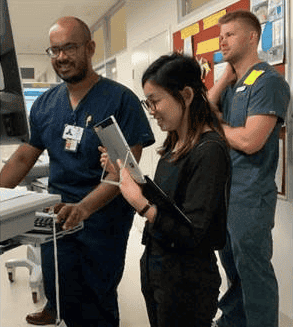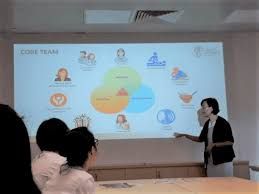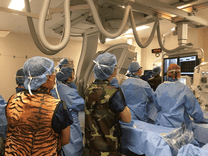Postoperative pain management, pain after vaginal delivery or cesarean section, has always been a strength of the Vinmec Healthcare System. To enhance professional skills and expertise, Vinmec has sent doctors for training in Seoul, South Korea.
In addition to pain caused by internal diseases, postoperative pain and pain after vaginal delivery or cesarean section are more concerning as they can be a source of distress. Vinmec has found ways to apply "pain management" to achieve the highest treatment effectiveness and safety.
The course took place from December 2017 to June 2018 at Montpellier University and Seoul, South Korea.
Doctors participating in the training:
Master, Doctor Vu Tuan Viet - Deputy Head of the Anesthesia Department, Head of the Pain Relief Unit, Vinmec Times City International General Hospital.

Training instructors:
CAP DE VILLA. X, VIEL. E, MACAIRE. P, Sang Hoon Lee, Montpellier University and Seoul, South Korea.
Training format:
Theory and practical workshop.
Training content:
Updating knowledge and practice on pain treatment.
Pain management methods at Vinmec:
1. Erector Spinae Plane Block (ESP)
When applying ESP, Vinmec has provided a painless experience for heart surgery patients for nearly two years and many other surgeries, helping patients undergo major surgeries with less discomfort. Patients can move early, shortening their hospital stay. The successful results at Vinmec have opened up opportunities for applying this anesthesia technique in open heart surgeries, chest surgeries, and rib fractures.
Notably, this achievement has made Vinmec the first hospital in the world to report successful open-heart surgeries with ESP anesthesia support.
This technique also helps manage pain effectively in abdominal surgeries like liver, stomach, kidney, and pancreas surgeries.
Some chronic pains, such as intercostal neuralgia caused by shingles in the acute or subacute stages, can also benefit from this method, alleviating the burden of pain for patients.
2. Epidural anesthesia
For peace of mind during vaginal delivery, many women choose epidural anesthesia to relieve pain during labor. This technique is performed when a woman experiences mild to moderate uterine contractions. It helps the labor progress in the best conditions, allowing the mother to conserve energy while still maintaining uterine contractions for the pushing phase.
After epidural anesthesia, the mother loses sensation from the abdomen down to the legs but can still move her legs, feel uterine contractions, and push effectively to deliver the baby.
Thanks to epidural anesthesia, labor is a different experience for mothers: They can give birth without the pain described by previous generations. Cases of prolonged labor are rare, and the risks of epidural anesthesia for both mother and baby are minimal.

3. Quadratus lumborum Block (QLB)
For cesarean section, the mother is given spinal anesthesia during surgery and pain relief on the first-day post-surgery using the quadratus lumborum block.
This technique selectively numbs the nerves that control the incision and uterine contractions, preventing pain signals from reaching the spinal cord and brain, thus reducing post-surgery pain for the mother.
With years of experience and modern ultrasound technology, Vinmec doctors accurately locate the quadratus lumborum block site to ensure the mother’s safety.
4. Pudendal Nerve Block
In addition to ultrasound-guided quadratus lumborum block, Vinmec also uses the pudendal nerve block technique to relieve pain in the perineum and lower abdomen, providing mothers with the most comfortable birthing experience, whether through natural birth or cesarean section.
Thanks to these measures, mothers delivering at Vinmec experience full pain relief, recover quickly, have normal bowel movements early, start moving and walking soon after, and avoid chronic pain.
Additionally, doctors do not need to use morphine, greatly reducing unwanted post-delivery and post-cesarean effects such as itching, paralytic ileus, nausea, chills, constipation, and dry mouth.
This anesthesia technique is also applied in sensitive-region surgeries like hemorrhoidectomy, perineal reconstruction, and anorectal surgeries under ultrasound guidance, helping manage pain effectively by targeting the affected area and blocking painful signals before they reach the brain.
5. Enhanced Recovery After Surgery (ERAS) Program
The Enhanced Recovery After Surgery (ERAS) program is a collection of multi-modal perioperative care protocols (pre-, intra, and post-surgery) designed to help patients recover quickly after surgery. Patients are thoroughly informed about ERAS before surgery, allowing them to participate confidently in the treatment and post-surgery care process with medical staff. Patients receive optimized nutrition, follow standardized anesthesia-pain relief protocols, and experience rapid recovery and early mobilization.
With the combination of robotic surgery and the ERAS program, Vinmec Times City International General Hospital has made remarkable achievements in cancer surgery: Patients eat immediately after surgery; on the first-day post-surgery, they are off medications, no IV fluids, and begin mobilization 6 hours after surgery; by the third day, they are discharged and return to normal life.
To arrange an appointment, please call HOTLINE or make your reservation directly HERE. You may also download the MyVinmec app to schedule appointments faster and manage your reservations more conveniently.









